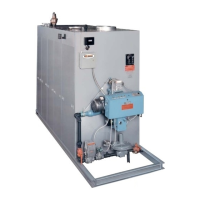damper. Combustion air openings for boilers which
are equipped with forced draft burners may be
reduced to 70% of that required for atmospheric gas
fired boilers. This is because the forced draft boiler is
not equipped with a draft diverter (so no air is required
for draft control).
COMBUSTION AIR OPENINGS - AREA REQUIRED:
Openings directly through outside wall -
One opening within 12 inches of the ceiling plus one
opening within 12 inches of the floor. Each opening
must have a minimum free area of 1 square inch per
4,000 Btu of total input of all air using appliances in
the room.
Example: A boiler room having two boilers with
500,000 Btu input would require two openings
through an outside wall, and each opening must have
at least 250 square inches of free area.
Openings through vertical ducts
-
One duct in the ceiling plus one duct terminating
within 12 inches of the floor. Each opening must have
a minimum free area of 1 square inch per 4,000 Btu
of total input of all air-using appliances in the room.
Example: A boiler room having four boilers with
250,000 Btu input would require two ducts, one in
ceiling and one terminating near the floor, and each
opening must have at least 250 square inches of free
area.
Openings through horizontal ducts
-
One duct opening within 12 inches of the ceiling plus
one duct opening within 12 inches of the floor. Each
opening must have a minimum free area of 1 square
inch per 2,000 Btu of total input for all equipment in
the room. NOTE: No rectangular duct may have a
dimension of less than 4 inches.
Example: A boiler room having 1 million Btu total
input would require two ducts, one in ceiling and one
near the floor, each opening having at least 500
square inches of free area.
Ventilation Air:
In addition to air needed for
combustion, sufficient air must be supplied for
ventilation, including air required for comfort and
proper working conditions for personnel in the boiler
room. In colder climates, provision should also be
made to heat the boiler room, if necessary, for
personnel comfort.
CAUTION
Protection from combustion air contamination: Where
corrosive or flammable process fumes are present in
the vicinity of the boiler room or the air stream for the
combustion air supply, it is essential that suitable
means be provided for their safe disposal. The boiler
room and the combustion air supply must not be
exposed to the fumes. Such fumes include, but are
not limited to, carbon monoxide, hydrogen sulfide,
ammonia, chlorine, and halogenated hydrocarbons.
NOTE: Halogenated hydrocarbons are particularly
injurious and corrosive after exposure to high
temperatures.
1.8 CHIMNEY, FLUE PIPE & DRAFT CONTROL - ATMOSPHERIC BOILERS
CODE COMPLIANCE
The installation must conform to the requirements of
NFPA 54, the National Gas Code (ANSI Z223.1-
1984), Part 7, "Venting of Equipment", or to the
applicable requirements of all local building codes. For
factory-built and listed chimney systems (such as type
B vent), consult the system manufacturer's
instructions for correct installation procedures. Gas
vents may be of any of the construction types listed in
this manual. No portion of a venting system may
extend into or pass through any circulating air duct or
plenum.
MINIMUM SAFE PERFORMANCE
Venting systems must be designed to develop positive
flow adequate to remove flue gases to the outside
atmosphere. Guidelines are provided in this manual
and in the National Fuel Gas Code, NFPA 54, for
sizing and design of flue gas venting system. For
additional reference to good practice in vent design,
refer to the "Chimney, Gas Vent, and Fireplace
Design" chapter of the ASHRAE Equipment
Handbook.
OUTSIDE VENTS AND CHIMNEYS
Outside uninsulated single wall pipe is not
recommended for use in cold climates for venting gas-
fired appliances since temperature differentials may
cause corrosion in such pipe, as well as poor draft on
start ups. When local experience indicates that
condensate may be a problem, provisions should be
made to drain off the condensate in the gas vent or
chimney.

